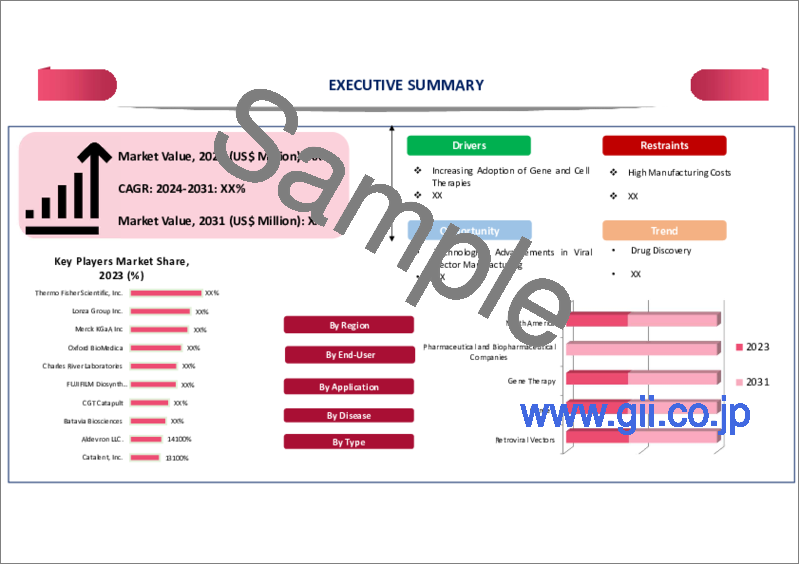|
|
市場調査レポート
商品コード
1319154
ウイルスベクター製造の世界市場-2023年~2030年Global Viral Vector Manufacturing Market - 2023-2030 |
||||||
カスタマイズ可能
適宜更新あり
|
|||||||
| ウイルスベクター製造の世界市場-2023年~2030年 |
|
出版日: 2023年07月31日
発行: DataM Intelligence
ページ情報: 英文 195 Pages
納期: 即日から翌営業日
|
- 全表示
- 概要
- 目次
市場概要
世界のウイルスベクター製造市場は、2022年に9億米ドルに達し、2023年から2030年の予測期間にCAGR 20.3%で成長し、2030年には38億米ドルに達すると予測されています。世界のウイルスベクター製造市場は近年著しい成長を遂げています。次世代ウイルスベクターへの注目の高まりが、ウイルスベクター製造市場の動向に対する需要を押し上げています。
ウイルスベクター製造市場は近年著しい成長と技術革新を示しています。ウイルスベクター製造は、アデノ随伴ウイルス(AAV)、レンチウイルス、アデノウイルスなどのウイルスベクターを様々な製造工程を経て生産します。これらのプロセスには、上流の生産、下流の精製、品質管理などが含まれます。全体として、ウイルスベクター製造市場は、遺伝子治療とワクチンが様々な疾患の治療と予防においてより顕著になるにつれて、継続的に拡大する態勢を整えています。
世界のウイルスベクター製造市場は、遺伝子療法や細胞療法の採用の増加、この分野における臨床試験の増加、遺伝子療法の進歩、ウイルスベクター製造の技術的進歩などの要因によって牽引されています。
市場力学
遺伝子・細胞治療の採用増加がウイルスベクター製造市場の成長を牽引
遺伝性疾患やがんなどの慢性疾患の有病率は世界的に増加しています。遺伝子・細胞治療は、根本的な遺伝子異常に対処したり、がん細胞に対する免疫反応を強化したりすることで、これらの疾患に対する有望な解決策を提供します。患者数の増加とアンメットメディカルニーズが、遺伝子・細胞治療に使用されるウイルスベクターの需要を牽引しています。
ウイルスベクターの製造は著しい進歩を遂げ、より効率的でスケーラブルな生産を可能にしています。ベクター設計、生産プラットフォーム、精製技術における革新は、ウイルスベクターの品質、安全性、収率を向上させています。こうした技術的進歩は遺伝子・細胞治療の商業化を促進し、市場の成長に寄与しています。
例えば、2023年4月、SK Pharmtecoの細胞・遺伝子治療用の臨床・商業用ウイルスベクター製造部門であるYposkesiは、レンチウイルスの生産効率と堅牢性を高めるために最適化されたレンチウイルス(LV)ベクター製造プラットフォームであるLentiSureの発売を発表しました。レンチウイルスまたはLVベクターは、細胞ベースの免疫腫瘍学療法の生産に使用されます。遺伝子導入システムとしての堅牢性は、細胞ベースのがん治療の成功を決定する上で極めて重要です。
研究におけるウイルスベクター需要の増加もウイルスベクター製造市場の成長を促進
研究におけるウイルスベクターの需要が増加するにつれて、それに対応し、増加する要件に対応するために生産量を増やす必要性が高まります。ウイルスベクター製造業者は、市場の需要を満たすために生産能力を拡大し、市場シェアの拡大につなげるでしょう。ウイルスベクターは、疾病治療のための細胞治療や遺伝子治療を開発するための臨床試験にも使用されています。
例えば、2023年6月9日、臨床段階のバイオテクノロジー企業であるアメリカン・ジーン・テクノロジーズは、HIVを治療するための遺伝子・細胞治療技術の開発を継続するために、新会社Addimmuneを立ち上げます。Addimmune社は、第1相HIV遺伝子・細胞治療臨床試験を成功に導いたAGT社の10年以上にわたる研究成果を基に、HIV治療法の開発のみに注力します。
遺伝子編集や遺伝子治療などの研究技術の絶え間ない進歩は、研究におけるウイルスベクターの応用を拡大してきました。ウイルスベクターは、これらの先端技術の送達手段として一般的に採用されており、正確なゲノム編集や遺伝子送達を可能にしています。研究者がこれらの技術を採用し、改良するにつれて、このような研究をサポートするウイルスベクターの需要は増加すると予想されます。
ウイルスベクターの短い保存期間が市場の成長を妨げる
ウイルスベクターは、その完全性と有効性を維持するために、超低温や凍結保存などの特定の保存条件を必要とします。このような保管条件は、特に遠隔地や資源が限られた地域に輸送する必要がある製品にとっては、コストがかかり、物流的にも困難な場合があります。特殊な保管・流通インフラが必要なため、サプライチェーン全体のコストと複雑さが増します。
ウイルスベクターの保存期間が短いため、市場での入手が制限されます。製造業者は、製品が患者の手元に届く前に期限切れとならないよう、在庫と生産スケジュールを注意深く管理しなければなりません。この制限は、供給不足、治療の遅れ、患者の需要に応えることの困難につながる可能性があります。
COVID-19の影響分析
COVID-19パンデミックは世界のウイルスベクター製造市場に大きな影響を与えました。COVID-19の大流行により、研究の焦点がSARS-CoV-2ウイルスを標的としたワクチンや治療法の開発へとシフトしました。多くの企業や研究機関がリソースや専門知識をウイルスベクターベースのCOVID-19ワクチンや治療法の開発に振り向けており、ウイルスベクター製造市場全体の成長に影響を与える可能性があります。
ロシア・ウクライナ紛争の影響分析
ロシア・ウクライナ紛争は、世界のウイルスベクター製造市場に中程度の影響を与えると推定されます。ウイルスベクターを用いた治療に対する規制の枠組みや承認は、地政学的要因の影響を受ける可能性があります。紛争は規制の方針や要件の変更につながり、ウイルスベクターベースの製品の承認スケジュールや市場アクセスに影響を与えます。こうした規制の不確実性は、世界のウイルスベクター製造市場に影響を及ぼす可能性があります。
目次
第1章 調査手法と調査範囲
第2章 定義と概要
第3章 エグゼクティブサマリー
第4章 市場力学
- 影響要因
- 促進要因
- 遺伝子治療と細胞治療の採用の増加
- 研究におけるウイルスベクターの需要増加
- 抑制要因
- ウイルスベクターの賞味期限の短さ
- 機会
- ウイルスベクター製造における技術の進歩
- 影響分析
- 促進要因
第5章 産業分析
- ポーターの5フォース分析
- サプライチェーン分析
- 価格分析
- 規制分析
第6章 COVID-19分析
第7章 タイプ別
- レトロウイルスベクター
- アデノウイルスベクター
- アデノ随伴ウイルスベクター
- その他
第8章 疾患別
- がん
- 遺伝子疾患
- 感染症
- その他
第9章 用途別
- 遺伝子治療
- ワクチン療法
第10章 エンドユーザー別
- 製薬会社およびバイオ製薬会社
- 研究機関
- その他
第11章 地域別
- 北米
- 米国
- カナダ
- メキシコ
- 欧州
- ドイツ
- 英国
- フランス
- スペイン
- イタリア
- その他欧州
- 南米
- ブラジル
- アルゼンチン
- その他南米
- アジア太平洋
- 中国
- インド
- 日本
- オーストラリア
- その他アジア太平洋地域
- 中東・アフリカ
第12章 競合情勢
- 競合シナリオ
- 市況/シェア分析
- M&A分析
第13章 企業プロファイル
- Sanofi SA
- 会社概要
- 製品ポートフォリオと説明
- 財務概要
- 主な発展
- Thermo Fisher Scientific Inc.
- Cobra Biologics Ltd
- Lonza Group Ltd
- Merck & Co.
- Oxford BioMedica
- CGT Catapult
- UniQure NV
- FUJIFILM Diosynth Biotechnologies
- Spark Therapeutics Inc.
第14章 付録
Market Overview
Global Viral Vector Manufacturing Market reached US$ 0.9 billion in 2022 and is expected to reach US$3.8 billion by 2030 growing with a CAGR of 20.3% during the forecast period 2023-2030. The global viral vector manufacturing market has witnessed significant growth in recent years. The increasing focus on next-generation viral vectors is driving up demand for viral vector manufacturing market trends.
The viral vector manufacturing market has witnessed significant growth and innovation in recent years. Viral vector manufacturing involves the production of viral vectors, such as adeno-associated viruses (AAV), lentiviruses, and adenoviruses, through various manufacturing processes. These processes include upstream production, downstream purification, and quality control. Overall, the viral vector manufacturing market is poised for continued expansion as gene therapies and vaccines become more prominent in the treatment and prevention of various diseases.
The global viral vector manufacturing market is driven by the factors such as the increasing adoption of gene and cell therapies, the increasing number of clinical trials in this field, advancements in gene therapies, and technological advancements in viral vector manufacturing.
Market Dynamics
Increasing Adoption of Gene and Cell Therapies Drives the Growth of the Viral Vector Manufacturing Market
The prevalence of genetic disorders and chronic diseases, such as cancer, is increasing globally. Gene and cell therapies offer promising solutions for these conditions by addressing the underlying genetic abnormalities or enhancing the immune response against cancer cells. The rising patient population and unmet medical needs drive the demand for viral vectors used in gene and cell therapies.
Viral vector manufacturing has witnessed significant advancements, enabling more efficient and scalable production. Innovations in vector design, production platforms, and purification techniques have improved the quality, safety, and yield of viral vectors. These technological advancements facilitate the commercialization of gene and cell therapies and contribute to market growth.
For instance, in April 2023, Yposkesi, SK Pharmteco's clinical and commercial viral vector manufacturing arm for cell and gene therapies, announced the launch of LentiSure, an optimized Lentiviral (LV) Vector manufacturing platform for increasing lentivirus production efficiency and robustness. Lentivirus or LV vectors are used to produce cell-based immuno-oncology therapies. Their robustness as a gene delivery system is vital in determining the success of any cell-based cancer treatment.
Increasing Demand for Viral Vectors in Research Also Drives the Growth of the Viral Vector Manufacturing Market
As the demand for viral vectors in research increases, there will be a corresponding and increasing need for higher production volumes to meet the growing requirements. Viral vector manufacturers will scale up their production capabilities to satisfy the market demand, leading to increased market share. The viral vectors are also used in clinical trials to develop cell and gene therapies for disease treatments.
For instance, on June 9, 2023, American Gene Technologies, a clinical-stage biotechnology company is launching a new company, Addimmune, to continue to develop gene and cell therapy technologies to cure HIV. Addimmune will focus solely on advancing an HIV cure, building upon more than a decade of work by AGT that led to a successful Phase 1 HIV gene and cell therapy clinical trial.
The continuous advancements in research techniques, such as gene editing and gene therapy, have expanded the applications of viral vectors in research. Viral vectors are commonly employed as delivery vehicles for these advanced technologies, enabling precise genome editing and gene delivery. As researchers adopt and refine these techniques, the demand for viral vectors to support such research is expected to rise.
The Short Shelf-Life of Viral Vectors Will Hamper the Growth of the Market
Viral vectors require specific storage conditions, such as ultra-low temperatures or cryopreservation, to maintain their integrity and efficacy. These storage requirements can be costly and logistically challenging, especially for products that need to be transported to remote or resource-limited areas. The need for specialized storage and distribution infrastructure adds to the overall costs and complexity of the supply chain.
The short shelf-life of viral vectors restricts their availability in the market. Manufacturers must carefully manage inventory and production schedules to ensure that products do not expire before reaching patients. This limitation can lead to supply shortages, delays in treatment, and difficulties in meeting patient demand.
COVID-19 Impact Analysis
The COVID-19 pandemic significantly impacted the global viral vector manufacturing market. The COVID-19 pandemic has prompted a shift in research focus towards the development of vaccines and therapies targeting the SARS-CoV-2 virus. Many companies and research institutions have redirected their resources and expertise towards developing viral vector-based COVID-19 vaccines and treatments, potentially affecting the growth of the overall viral vector manufacturing market.
Russia-Ukraine War Impact Analysis
The Russia-Ukraine conflict is estimated to have a moderate impact on the global viral vector manufacturing market. Regulatory frameworks and approvals for viral vector-based therapies can be influenced by geopolitical factors. The conflict leads to changes in regulatory policies and requirements, affecting the approval timelines and market access for viral vector-based products. These regulatory uncertainties can have implications for the global viral vector manufacturing market.
Segment Analysis
The global viral vector manufacturing market is segmented based on type, disease, application, end-user, and region.
Adenoviral Vectors from the Type Segment Accounts for 37.7% of the Viral Vector Manufacturing Market Share
Adenoviral vectors are derived from adenoviruses, which are non-enveloped viruses with a large genome capable of accommodating sizable transgenes. Adenoviral vectors exhibit high transduction efficiency, meaning they can efficiently deliver therapeutic genes or antigens into target cells. This efficient transduction is due to their ability to infect a broad range of dividing and non-dividing cells, making them suitable for various applications in gene therapy and vaccine delivery.
Adenoviral vectors can stimulate robust immune responses, making them valuable in vaccine development. They can induce both humoral (antibody-mediated) and cellular (T-cell-mediated) immune responses against the encoded antigens. This immunogenicity is advantageous for developing vaccines against infectious diseases and cancer immunotherapies.
For instance, in October 2022, TEHRAN (Tasnim), the Chinese city of Shanghai started administering inhalable COVID-19 booster vaccinations. The vaccine is an adenovirus type-5 vector-based COVID-19 vaccine administered via oral inhalation.
Geographical Analysis
North America Accounted for Approximately 39.8% of the Market Share Owing to the Presence of Major Players and Advanced Healthcare Infrastructure
North America is home to numerous leading biotechnology and pharmaceutical companies that actively engage in viral vector manufacturing. These companies have established expertise in gene therapy and vaccine development and possess robust manufacturing capabilities. Their investments in research and development, manufacturing infrastructure, and clinical trials contribute to the market's growth and dominance in the region.
For instance, in May 2023, AGC Biologics announced the launch of its BravoAAV and ProntoLVV viral vector platforms. Leveraging three decades of Lentiviral vector (LVV) and Adeno-Associated Viral vector (AAV) development, manufacturing, and analytical experience, AGC Biologics' new platforms offer fast, efficient, and reproducible clinical and commercial GMP production and release.
North America boasts a well-developed healthcare infrastructure with advanced facilities and expertise in genetic medicine. The presence of renowned academic institutions, research centers, and healthcare systems fosters collaborations and knowledge exchange among industry stakeholders. This infrastructure supports the development, manufacturing, and commercialization of viral vectors for gene therapies and vaccines.
Competitive Landscape
The major global players in the viral vector manufacturing market include: Sanofi SA, Thermo Fisher Scientific Inc., Cobra Biologics Ltd, Lonza Group Ltd, Merck & Co., Oxford BioMedica, CGT Catapult, UniQure NV, FUJIFILM Diosynth Biotechnologies, and Spark Therapeutics Inc.
Why Purchase the Report?
- To visualize the global viral vector manufacturing market segmentation based on type, disease, application, end-user, and region, as well as understand key commercial assets and players.
- Identify commercial opportunities by analyzing trends and co-development.
- Excel data sheet with numerous data points of viral vector manufacturing market-level with all segments.
- PDF report consists of a comprehensive analysis after exhaustive qualitative interviews and an in-depth study.
- Product mapping available as excel consisting of key products of all the major players.
The global viral vector manufacturing market report would provide approximately 53 tables, 54 figures, and 195 Pages.
Target Audience 2023
- Manufacturers/ Buyers
- Industry Investors/Investment Bankers
- Research Professionals
- Emerging Companies
Table of Contents
1. Methodology and Scope
- 1.1. Research Methodology
- 1.2. Research Objective and Scope of the Report
2. Definition and Overview
3. Executive Summary
- 3.1. Snippet by Type
- 3.2. Snippet by Disease
- 3.3. Snippet by Application
- 3.4. Snippet by End-User
- 3.5. Snippet by Region
4. Dynamics
- 4.1. Impacting Factors
- 4.1.1. Drivers
- 4.1.1.1. Increasing Adoption of Gene and Cell Therapies
- 4.1.1.2. Increasing Demand for Viral Vectors in Research
- 4.1.2. Restraints
- 4.1.2.1. Short Shelf-Life of Viral Vectors
- 4.1.3. Opportunity
- 4.1.3.1. Technological Advancements in Viral Vector Manufacturing
- 4.1.4. Impact Analysis
- 4.1.1. Drivers
5. Industry Analysis
- 5.1. Porter's 5 Forces Analysis
- 5.2. Supply Chain Analysis
- 5.3. Pricing Analysis
- 5.4. Regulatory Analysis
6. COVID-19 Analysis
- 6.1. Analysis of COVID-19
- 6.1.1. Scenario Before COVID-19
- 6.1.2. Scenario During COVID-19
- 6.1.3. Scenario Post COVID-19
- 6.2. Pricing Dynamics Amid COVID-19
- 6.3. Demand-Supply Spectrum
- 6.4. Government Initiatives Related to the Market During the Pandemic
- 6.5. Manufacturer's Strategic Initiatives
- 6.6. Conclusion
7. By Type
- 7.1. Introduction
- 7.1.1. Market Size Analysis and Y-o-Y Growth Analysis (%), By Type
- 7.1.2. Market Attractiveness Index, By Type
- 7.2. Retroviral Vectors *
- 7.2.1. Introduction
- 7.2.2. Market Size Analysis and Y-o-Y Growth Analysis (%)
- 7.3. Adenoviral Vectors
- 7.4. Adeno-Associated Viral Vectors
- 7.5. Others
8. By Disease
- 8.1. Introduction
- 8.1.1. Market Size Analysis and Y-o-Y Growth Analysis (%), By Disease
- 8.1.2. Market Attractiveness Index, By Disease
- 8.2. Cancer *
- 8.2.1. Introduction
- 8.2.2. Market Size Analysis and Y-o-Y Growth Analysis (%)
- 8.3. Genetic Disorders
- 8.4. Infectious Diseases
- 8.5. Others
9. By Application
- 9.1. Introduction
- 9.1.1. Market Size Analysis and Y-o-Y Growth Analysis (%), By Application
- 9.1.2. Market Attractiveness Index, By Application
- 9.2. Gene Therapy *
- 9.2.1. Introduction
- 9.2.2. Market Size Analysis and Y-o-Y Growth Analysis (%)
- 9.3. Vaccinology
10. By End-User
- 10.1. Introduction
- 10.1.1. Market Size Analysis and Y-o-Y Growth Analysis (%), By End-User
- 10.1.2. Market Attractiveness Index, By End-User
- 10.2. Pharmaceutical and Biopharmaceutical Companies *
- 10.2.1. Introduction
- 10.2.2. Market Size Analysis and Y-o-Y Growth Analysis (%)
- 10.3. Research Institutes
- 10.4. Others
11. By Region
- 11.1. Introduction
- 11.1.1. Market Size Analysis and Y-o-Y Growth Analysis (%), By Region
- 11.1.2. Market Attractiveness Index, By Region
- 11.2. North America
- 11.2.1. Introduction
- 11.2.2. Key Region-Specific Dynamics
- 11.2.3. Market Size Analysis and Y-o-Y Growth Analysis (%), By Type
- 11.2.4. Market Size Analysis and Y-o-Y Growth Analysis (%), By Disease
- 11.2.5. Market Size Analysis and Y-o-Y Growth Analysis (%), By Application
- 11.2.6. Market Size Analysis and Y-o-Y Growth Analysis (%), By End-User
- 11.2.7. Market Size Analysis and Y-o-Y Growth Analysis (%), By Country
- 11.2.7.1. U.S.
- 11.2.7.2. Canada
- 11.2.7.3. Mexico
- 11.3. Europe
- 11.3.1. Introduction
- 11.3.2. Key Region-Specific Dynamics
- 11.3.3. Market Size Analysis and Y-o-Y Growth Analysis (%), By Type
- 11.3.4. Market Size Analysis and Y-o-Y Growth Analysis (%), By Disease
- 11.3.5. Market Size Analysis and Y-o-Y Growth Analysis (%), By Application
- 11.3.6. Market Size Analysis and Y-o-Y Growth Analysis (%), By End-User
- 11.3.7. Market Size Analysis and Y-o-Y Growth Analysis (%), By Country
- 11.3.7.1. Germany
- 11.3.7.2. U.K.
- 11.3.7.3. France
- 11.3.7.4. Spain
- 11.3.7.5. Italy
- 11.3.7.6. Rest of Europe
- 11.4. South America
- 11.4.1. Introduction
- 11.4.2. Key Region-Specific Dynamics
- 11.4.3. Market Size Analysis and Y-o-Y Growth Analysis (%), By Type
- 11.4.4. Market Size Analysis and Y-o-Y Growth Analysis (%), By Disease
- 11.4.5. Market Size Analysis and Y-o-Y Growth Analysis (%), By Application
- 11.4.6. Market Size Analysis and Y-o-Y Growth Analysis (%), By End-User
- 11.4.7. Market Size Analysis and Y-o-Y Growth Analysis (%), By Country
- 11.4.7.1. Brazil
- 11.4.7.2. Argentina
- 11.4.7.3. Rest of South America
- 11.5. Asia-Pacific
- 11.5.1. Introduction
- 11.5.2. Key Region-Specific Dynamics
- 11.5.3. Market Size Analysis and Y-o-Y Growth Analysis (%), By Type
- 11.5.4. Market Size Analysis and Y-o-Y Growth Analysis (%), By Disease
- 11.5.5. Market Size Analysis and Y-o-Y Growth Analysis (%), By Application
- 11.5.6. Market Size Analysis and Y-o-Y Growth Analysis (%), By End-User
- 11.5.7. Market Size Analysis and Y-o-Y Growth Analysis (%), By Country
- 11.5.7.1. China
- 11.5.7.2. India
- 11.5.7.3. Japan
- 11.5.7.4. Australia
- 11.5.7.5. Rest of Asia-Pacific
- 11.6. Middle East and Africa
- 11.6.1. Introduction
- 11.6.2. Key Region-Specific Dynamics
- 11.6.3. Market Size Analysis and Y-o-Y Growth Analysis (%), By Type
- 11.6.4. Market Size Analysis and Y-o-Y Growth Analysis (%), By Disease
- 11.6.5. Market Size Analysis and Y-o-Y Growth Analysis (%), By Application
- 11.6.6. Market Size Analysis and Y-o-Y Growth Analysis (%), By End-User
12. Competitive Landscape
- 12.1. Competitive Scenario
- 12.2. Market Positioning/Share Analysis
- 12.3. Mergers and Acquisitions Analysis
13. Company Profiles
- 13.1. Sanofi SA *
- 13.1.1. Company Overview
- 13.1.2. Product Portfolio and Description
- 13.1.3. Financial Overview
- 13.1.4. Key Developments
- 13.2. Thermo Fisher Scientific Inc.
- 13.3. Cobra Biologics Ltd
- 13.4. Lonza Group Ltd
- 13.5. Merck & Co.
- 13.6. Oxford BioMedica
- 13.7. CGT Catapult
- 13.8. UniQure NV
- 13.9. FUJIFILM Diosynth Biotechnologies
- 13.10. Spark Therapeutics Inc.
LIST NOT EXHAUSTIVE
14. Appendix
- 14.1. About Us and Services
- 14.2. Contact Us






